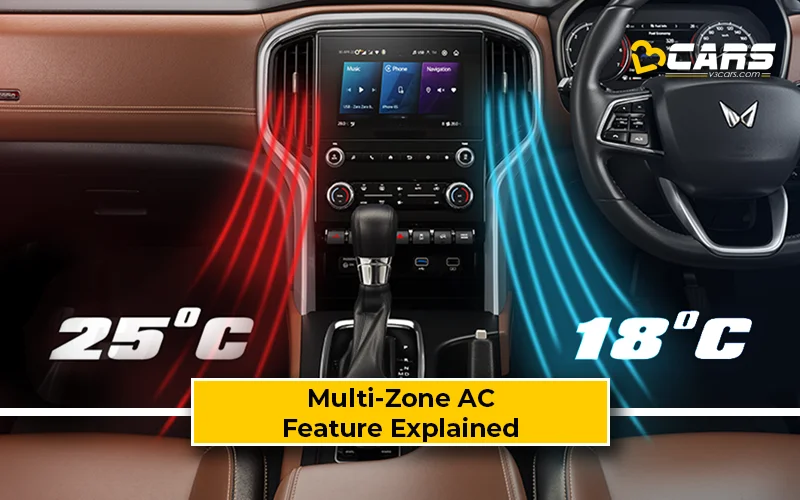Multi-Zone AC – Feature Explained
Comfort inside a car goes beyond just plush seats and good insulation. Cabin temperature plays a huge role in enhancing comfort. That’s where multi-zone climate control systems come in. They let different occupants in the car set their own preferred temperature, ensuring everyone stays comfortable no matter where they sit.

In this article, we explain what multi-zone AC is, how it works, and why it’s becoming a popular feature in modern, mass-market cars.
What Is A Multi-Zone AC?
A multi-zone AC, also known as multi-zone climate control, is an advanced air conditioning system that allows independent temperature control for different areas or “zones” of the car cabin.
For example, dual-zone AC lets the driver and front passenger set separate temperature levels, whereas tri-zone AC extends this comfort to the rear passengers as well. So while the driver may prefer a cooler temperature, the passengers can increase their temperature for a more comfortable journey without affecting each other’s climate preferences.
How Does A Multi-Zone AC Work?
Multi-zone climate control system use a combination of sensors, actuators, and electronic climate modules to manage airflow and temperature in different parts of the car.
Here’s how it works step-by-step:
1. Individual Temperature Sensors: Each zone has its own temperature sensor that monitor cabin temperature.
2. Dedicated Air Vents And Dampers: Motorised flaps control how much hot or cold air enters each zone.
3. Automatic Adjustment: The system automatically adjusts fan speed, airflow direction, and cooling intensity to maintain the set temperature for each zone.
4. Separate Control Panels: Occupants can adjust the temperature and fan settings using control panels, either on the dashboard (for front passenger) or via rear control controls (for rear passnegers).
Types Of Multi-Zone AC Systems
Here are the different types of multi-zone AC systems in cars:
|
|
||
|
|
|
|
|
|
|
|
|
|
|
|
|
|
|
|
What Are The Pros And Cons Of Multi-Zone AC?
Here are the advantages of multi-zone AC:
- Personalised Comfort: Each occupant can enjoy their preferred temperature, reducing arguments over the AC settings.
- Enhanced Rear Passenger Experience: Rear occupants get better control over airflow and temperature, which is ideal for families or chauffeur-driven owners.
- Improved Cabin Harmony: Reduces temperature differences than can cause discomfort during long drives.
- Automatic Function: The system constantly self-adjusts to maintain comfort without manual intervention.
Here are the disadvantages of multi-zone AC:
- Added Cost: Found mostly in higher variants or premium models, increasing the overall car price.
- Complexity: More sensors and actuators mean higher maintenance or repair costs if the system fails.
- Slightly Higher Power Consumption: Operating multiple temperature zones can marginally increase load on the compressor and engine.
Can You Add A Multi-Zone AC Aftermarket?
No, a true multi-zone climate control system cannot be installed aftermarket. It requires integrated sensors, actuators, and a compatible HVAC system controlled by the vehicle’s ECU. While you can add rear AC vents or auxiliary blowers in some cars, they don’t offer independent temperature control and aren’t true multi-zone systems.
Also Read:
Helpful Tools:
- Fuel Cost Calculator for Cars – Know your monthly fuel expense based on usage and mileage
- Car On-Road Price Calculator – Convert ex-showroom to on-road price for any city
Sell Used Car Online – Enter your car and contact details to get an instant price estimate and book a free inspection with our partner network


0 Comments